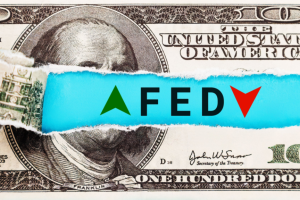
Growth stocks have been fairly resilient, considering challenges such as high interest rates and the prospect of a recession within the next twelve months. This resilience notwithstanding, however, make no mistake. There are plenty of growth stocks at risk.
In fact, many of the high-profile growth names that have either performed strongly or held steady throughout 2023 could be vulnerable to moderate to large declines in 2024.
If interest rates stay at elevated levels, besides affecting the valuation of growth stocks (which are more rate-sensitive than stocks overall), this will also continue to impact economic growth. A slowdown or recession could hinder growth companies’ revenue and earnings in upcoming quarters.
With this in mind, avoid, or at the very least, tread carefully, with these seven growth stocks at risk.
Airbnb (ABNB)

Airbnb (NASDAQ:ABNB) shares are up by over 36% since January, but based on recent price action, it’s clear the market expects a slowdown just around the corner for the lodging marketplace platform operator.
Yet while ABNB stock has pulled back in more recent months, further declines may be the itinerary. Even after this pullback, investors could underestimate the impact of the dampening demand currently seen for travel lodging, that management recently disclosed in the company’s latest earnings conference call.
To some, a slowdown may seem already baked into ABNB’s valuation, with shares trading for just 13.8 times estimated 2024 earnings. However, with a onetime item boosting net income last quarter, Airbnb isn’t as cheap as it may seem on a screener.
Shares trade for around 26.5 times estimated 2024 earnings, which could be revised down if travel demand weakens from here.
DraftKings (DKNG)

Yes, calling DraftKings (NASDAQ:DKNG) one of the growth stocks at risk is currently a contrarian take.
Following the online casino and sports book operator’s latest quarterly earnings release, confidence keeps rising that the company will hit profitability targets, and continue to grow as the U.S. gambling market continues to expand.
Yet while bullish sentiment remains high for DKNG stock, this could change in the year ahead. DraftKings has reported very high rates of revenue growth in recent quarters, but based upon its 2024 revenue guidance (between $4.5 billion and $4.8 billion), top-line growth appears set to decelerate from nearly 65% this year, to between 21.8% and 29.9% next year.
If that’s not bad enough, as I’ve discussed recently, new competition, plus the fact the U.S. online gambling legalization wave has slowed down, may impact DraftKings’ ability to keep “crushing it” in terms of growth.
Netflix (NFLX)

Netflix (NASDAQ:NFLX) shares encountered a slump in the early fall, but since the streaming giant’s latest earnings release in late October, the stock has taken off once again. In a matter of weeks, NFLX has rallied from around $346 to around $436 per share, a 26% move higher.
However, before hopping on the NFLX stock bandwagon, keep a few things in mind. For one, even as the company’s subscriber growth has re-accelerated in recent quarters, this growth resurgence may only be temporary, the result of Neftlix’s crackdown on password sharing, and the launch of an lower-priced ad-supported subscription tier last year.
NFLX may maintain its valuation premium (35.7 times earnings, versus single-digit/low-teens forward multiples for its “old media” competitors), but if the company re-enters a growth slump, and/or competition from rival platforms intensifies, this valuation premium could start to evaporate.
Palantir Technologies (PLTR)

With ‘AI mania’ simmering down, is Palantir Technologies (NYSE:PLTR) no longer one of the growth stocks at risk?
Not so fast! Shares in the AI software firm remain not too far below their 52-week highs. Analysts and investors remain very confident in Palantir’s ability to capitalize on the artificial intelligence trend.
But even as the company’s recent “beat and raise” quarter, bullish commentary about PLTR stock, including an argument from Wedbush’s Dan Ives that Palantir is the “Lionel Messi of AI,” seems a bit overdone.
Despite talk about Palantir’s AI edge, analyst consensus calls for revenue growth in 2024 of around 19.4%, and earnings growth of 16%.
While solid, this level of growth hardly justifies PLTR’s high forward valuation (73.9 times earnings). PLTR needs to handily beat expectations to justify another rally. Even worse, a minor slowdown in demand could spark a serious reversal.
Rivian Automotive (RIVN)

Among the U.S. electric vehicle upstarts, Rivian Automotive (NASDAQ:RIVN) has arguably had the greatest level of success. At least, compared to early-stage peers like Lucid Group (NASDAQ:LCID).
Even so, while Rivian has so far in 2023 experienced a massive scaling up of production and deliveries, and may be on track to produce 54,000 vehicles this year, a growth slowdown may lie ahead for the company, and for RIVN stock. High interest rates are leading to softening EV demand. EV makers are in turn slashing prices.
This turn of events could hurt Rivian in two ways. First, a price war among U.S. EV makers could impact sales growth. Second, and more importantly, it may make it even more difficult for Rivian to make progress narrowing losses, and hitting profitability. These concerns are already weighing on RIVN, and may continue to do so.
Tesla (TSLA)

Tesla (NASDAQ:TSLA) shares experienced an epic comeback during the first half of 2023. Investors rushed back into the widely followed EV stock, as the company’s aggressive price-cutting efforts helped to sustain deliveries growth.
Since July, however, TSLA stock has coughed back a fair amount of these gains. In more recent quarters, deliveries growth has fallen short of expectations. With volume growth failing to make up for them, the price cuts are resulting in falling margins and lower profitability. Even after tumbling over the past few months, TSLA remains one of growth stocks at risk.
As discussed above with Rivian, softening EV demand bodes badly for results in the coming quarters. As results remain underwhelming, it could be difficult for Tesla shares to maintain their massive valuation premium (65.8 times forward earnings) to traditional automakers (which for the most part trade at forward earnings multiples in the single-digits).
Upstart Holdings (UPST)

It may seem too late to say Upstart Holdings (NASDAQ:UPST) risks experiencing a growth slowdown. The fintech firm, which operates a lending platform powered by AI-based underwriting practices, has already experienced not just a growth slowdown, but a severe contraction in revenue.
However, with the rise of AI top of mind in 2023, some investors have become bullish that rising adoption of AI-based lending practices could help outweigh a tough lending market.
Sequential revenue growth during Q2 may have suggested that this was starting to take shape. Yet as seen in the company’s recently-released Q3 2023 results, revenue barely budged on a sequential basis, and was down by 14% year-over-year.
Updates to guidance signal more lackluster results ahead. If you were banking on a comeback for UPST stock, think otherwise, as weak loan demand persists, hindering a comeback. After declining more than 70% since August, shares could keep falling.
On the date of publication, Thomas Niel did not hold (either directly or indirectly) any positions in the securities mentioned in this article. The opinions expressed in this article are those of the writer, subject to the InvestorPlace.com Publishing Guidelines.
Technology, Artificial Intelligence, Cybersecurity, Consumer Discretionary, Automotive, Electric Vehicles, Financial, Fintech, Communications, Media, Streaming





